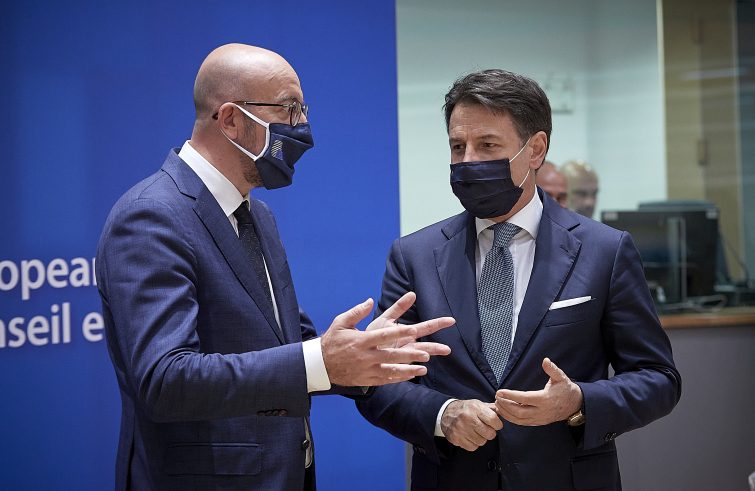
When in December 2020 the opposition of the Polish and Hungarian governments was finally overcome – caused by their arrogant claim to benefit from common funds financed by European taxpayers while not complying with EU regulations and rule of law – and when both the EU’s multiannual financial framework for 2021-2027 and the creation of an additional €750 billion stimulus package were jointly approved at European level, Italy was presented with its greatest challenge. Or, more appropriately, the most arduous challenge. In fact the greatest challenge was convincing 27 different countries to share resources and sovereignty. Yet the most difficult challenge for us is the one we have so often lost, both as a State, as citizens and as businesses.
The challenge that lies ahead is to put into practice what has been planned, i.e. to conclude dozens of programmes and projects on time and within budget.
Plenty of money, low interest rates. The first step towards implementation was the development of a “National Recovery and Resilience Plan”, approved on 12 January by the Council of Ministers. What are its key points? The European aid plan provides for €209 billion for Italy (resources are slightly higher as the figures add on to another previously approved EU fund), to be committed by 2023 but with spending lasting until 2026 (it is worth noting that these funds will be added to ordinary EU budget funding for Italy, amounting to almost €100 in the period 2021-27). Of these, €65.5 billion are non-repayable grants, while the remaining funds are loans with favourable interest rates and long-term repayment.
Six priority areas. The National Recovery and Resilience Plan allocates the over €200 billion package to six focal areas, called “missions.” A total of €45 billion has been earmarked for digitalisation, support to innovation, tourism and culture (the first mission); almost €70 billion will go to assisting green transition ( across the board, from energy efficiency in industry, transport and housing, to the promotion of circular economy, i.e. minimising waste through reusing, repairing, refurbishing); €32 billion to mobility infrastructure (railways, roads); €25 billion to education and research; €21 billion to employment, family and territorial cohesion policies; €20 billion to health ( primary care, telemedicine, healthcare).
“A bit of everything.” What is the underlying approach of the plan? It obviously covers a variety of sectors, somewhat encompassing ‘a bit of everything’, yet with two distinct priorities: green transition and digitisation (a substantial proportion of the remaining four missions also include resources for green and digital transition). Moreover, national plans must be consistent with the EU framework and the priorities identified at EU level – green transition and digitalisation. Surprisingly enough, the EU plan places strong emphasis on these two areas even after, or because of, the coronavirus outbreak.This is a commendable but by no means easy challenge, since
the crisis caused by the epidemic can and should also be seen as an opportunity to radically rethink our way of working and living in Europe.
In this respect the Italian plan reflects a decision taken at Community level.
Which government? The National Recovery and Resilience Plan will now require parliamentary scrutiny and discussion with social partners. The final version then needs to be approved by the European Commission and, in fact, also by the European Council that brings together EU Member States. Then comes the greatest challenge – implementation. First, we have yet to know which government will be in office by then, and to what extent it will be backed by Parliament. After that, a mandate will be given to each administration for its implementation (ministries, agencies, regions, public and private companies), in some cases involving legally complex procedures. Having discarded the senseless proposal to set up a parallel structure of hundreds of outsourced experts in charge of coordinating the plan (a “parallel administration”: recruited according to which criteria? With which signatory powers and responsibilities? Operating under which management system?), the primary challenge will be how to make the best use of existing administrative capacities and how to integrate them (not replace them) with all available resources to successfully master large-scale and high-impact projects (from infrastructure to green and digital transition)
Age-old Italian vices. At that stage, not only the Country’s poor administrative and management skills will be put to the test. In fact I’m afraid that long-standing Italian vices will resurface, including a sense of fatalism (with the slogan “yet again, we expect great delays, we can’t help it”; other EU countries will respond by withdrawing appropriated funds because we failed to spend them efficiently) and a touch of cynicism (“what can we do about it, some corruption is inevitable!”; this remark is quite true and does not only apply to Italy, but the answers will be found in the attentive scrutiny paid by northern countries’ media outlets as to how EU money is spent, given that these are resources guaranteed also by Finnish, Danish or Dutch taxpayers, unwilling to accept excuses).
Sense of responsibility. In order to meet these challenges, it will be extremely useful for all those involved in the implementation process to be subjected to a twofold pressure:
the pressure exerted by our European partners, who are not inclined to condone certain vices, and the moral and ethical pressure from the next generation of Italians.
Ultimately, they are the recipients of this plan, called Next Generation EU, and it is to them that the countless actors – public administrations, private companies, civil society – tasked with its implementation, should give their first thought and be guided by a high sense of responsibility towards posterity and the future of Italy and Europe.
*Professor of Public Management at the Open University, United Kingdom










